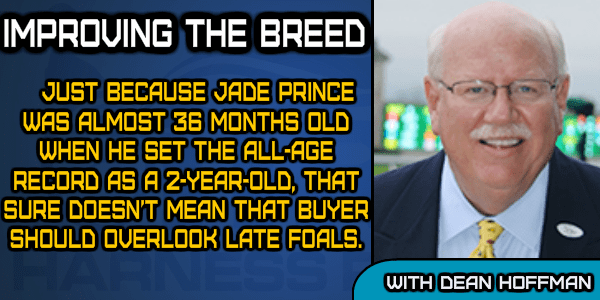April Foals
Is early April the ideal time for foals to arrive? Dean Hoffman takes a look.
by Dean A. Hoffman
This is the ideal time for your mare to have her foal.
Actually, the previous sentence is my idea of an April Fool’s joke because the ideal time for your mare to have a foal is when Mother Nature decrees she is damn good and ready.
For most mares, that is a tad longer than 11 months from conception. But anyone who’s worked with broodmares understands that they do things on their own schedule.
I do think that early April is an ideal time for standardbred mares to foal because spring is arriving in many of the areas where most mares reside in North America. There is much to be said about the benefits of getting a foal out the day after it’s born and letting it romp in the sunshine and benefit from the emerging green grass.
There are exceptions to every rule, however, and we can cite some dramatic examples. In 1976, Jade Prince became the first 2-year-old to hold the all-age race record when he won in 1:54.1 at The Red Mile for trainer/driver Jack Kopas. He broke the race record held then by the 4-year-old Albatross.
The ironic thing is that Jade Prince set a world record for 2-year-olds in 1976 despite the fact that he was foaled on Nov. 25, 1973.
The math doesn’t seem right, but that was during a period when the USTA had a rule that counted November and December foals as being born in the following year. The rule was passed to allow for “early breeding” in an effort to give trainers more mature horses when they raced.
Many breeders hooted and howled in protest about the early breeding rule, but it also had strong proponents in prominent individuals such as Delvin Miller and John F. Simpson, head of Hanover Shoe Farms.
Both Miller and Simpson were respected voices although one of Simpson’s brightest stars on the track, Bullet Hanover, was a June 7 foal and established a new world record for juveniles in August, 1959.
Two juvenile pacing stars in the 1960s with late foaling dates were Bret Hanover and Best Of All, both late May foals and still 2-year-old champions.
Just because Jade Prince was almost 36 months old when he set the all-age record as a 2-year-old, that sure doesn’t mean that buyer should overlook late foals.
Let’s look at the 10 richest freshman pacing colts in history. Half of them were foaled later than May 20. These are: Fortune Teller (May 21), Praised Dignity (May 22), I Am A Fool (June 3), Die Laughing (June 11), and the Brobdingnagian Barberry Spur (June 5).
Conversely, you will find some richest freshman pacers that were foaled early, including Jereme’s Jet (Feb. 15) and Artsplace (March 2).
The extremes aren’t quite as demonstrable in the richest juvenile trotting colts, but if a trainer by-passed colts foals after May 1, he would have missed Wesgate Crown (May 15), Donato Hanover (May 3) and Donerail (May 26).
Superstar trotting colt Muscle Hill, who never did anything wrong on the track, was a Feb. 15 foal.
Now, for the opposing viewpoint: the superstar freshman trotting filly Snow White was a Jan. 22 foal. She earned $1.25 filly, making her the richest 2-year-old trotting lass ever.
Former Horse of the Year Bee A Magician was also an early foal: Feb. 1.
I noticed, however, a curious trend among freshman trotting fillies. Many of the best have been developed by Jimmy Takter and many of them are later foals. These would include the current champion Manchego (May 17), as well as past stars such as Solveig (May 18), Costa Rica (May 20) and Shake It Cerry (May 28).
Perry Soderberg is a widely-respected expert on yearling selection and he screens many yearlings for Takter to inspect.
“Even though I never excluded any horse on a birthdate alone, I am a bit more cautious when they are born really late,” explains Soderberg. “What I always do is to use a yearling’s birthdate to evaluate size and physical maturity. A difference of three or four months in age can make a big difference in size and maturity on a yearling. Even two months can make a difference.
“It doesn’t always make a difference, but it is just another tool to help me evaluate each yearling.”
Among freshman pacing fillies, we find the two richest in history — Miss Easy and Immortality — were foaled before today’s date. Miss Easy was born on the Ides of March (March 15) while Immortality arrived on Feb. 18.
The one trend that I noticed among the list of richest 2-year-old pacing fillies is that most of them arrived prior to May 1.
This has been only a cursory, superficial glance at foaling dates and performance of 2-year-olds. This issue is one that would easily lend itself to computer analysis bringing in various factors. It could be a fascinating topic.

















